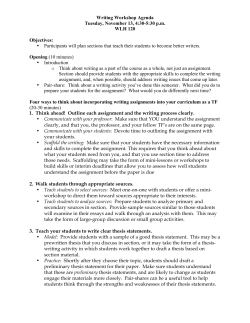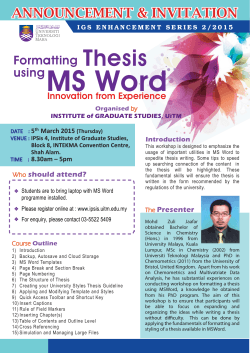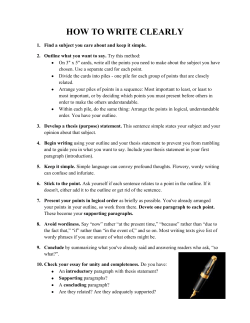
- Widya Mandala Catholic University Surabaya
CHAPTER 1 INTRODUCTION 1.1 The Background of the Study Students, especially college and university students always deal with writings. They have to write as a fulfillment of the requirements for their degrees, they have to write to complete their assignments, to do their exams, or even to increase their abilities in writing. Students have to improve their capability in writing, so that they can produce a good writing. In students‟ study period, students must be assigned to make academic writings. Academic writing can be differentiated from other kinds of writing such as personal, literary, journalistic, or business writing. It is assumed that “academic writing is a set of conventions seen in a thesis or a published paper in every discipline” (Murray, 2005: 10). From the statement above, it can be implied that thesis is one of the form of academic writing. There are some researchers who have investigated thesis conclusions and lexical phrases in academic writing. The first previous study about structures in thesis conclusions is a thesis entitled “The Structure of PhD Conclusion Chapters” written by David Bunton in 2005. The second previous study about lexical phrases in academic writing is a thesis entitled “The Acquisition of Lexical Phrases in Academic Writing: A Longitudinal Case Study” written by Jie Li and Norbert Schmitt in 2009. 2 The writer decided to conduct a research on thesis conclusions because from the previous studies the writer found that there were no studies that have investigated the structures and the lexical phrases of thesis conclusions. The previous study written by David Bunton only investigated structures of conclusion chapters. In addition, before conducting this study the writer did not know whether the undergraduate English Department students‟ thesis conclusions were complete or incomplete based on Bunton template, then, after conducting this study the writer knew that the undergraduate English Department students‟ thesis conclusions were mostly incomplete based on Bunton template. From 20 undergraduate English Department academic year 2006 students‟ thesis conclusions only one thesis conclusion which has complete subsections based on Bunton template. According to Paltridge and Starfield (2007), conclusion section is where students both summarize and „wrap up‟ their writing work. Conclusion is not the same as a summary of findings. Summaries are a statement of what the student has found out. Conclusions are statement of the significance of what a student has found out. In addition, conclusion is not as long and extensive as discussion section. Often a conclusion chapter is only a few pages long. Moreover, there are some reasons to conduct a research on thesis conclusion. They are: 1. Conclusion is the last chance to leave a memorable impression on the reader‟s mind. 3 2. Conclusion is the final part of academic writing, so the examiner will read it and it will leave the most lasting impression. 3. Conclusion is important because it sums up important arguments. 4. Conclusion is important because it highlights areas of further study. 5. Conclusion gives an opportunity to further explore a topic. 6. Conclusion provides suggestions for readers regarding an issue. The writer conducted this study to find out the structures of undergraduate students‟ thesis conclusions and the lexical phrases of undergraduate students‟ thesis conclusions. This study only focuses on the thesis conclusions of undergraduate students of the English Department Widya Mandala Catholic University. The undergraduate students of English Department Widya Mandala Catholic University have competencies in writing in English because they have passed Writing 1, Writing 2, Writing 3, and Writing 4 courses. In addition, they have also passed Scientific Writing course before they wrote their thesis, so they should be able to write proper thesis conclusions since their lecturers have taught them. Furthermore, the writer used Bunton template because according to the writer‟s opinion thesis conclusion structure based on Bunton template may help the thesis writer to write thesis conclusion in the logical way. The writer did not only investigate the structure of students‟ thesis conclusions, but also the lexical phrases of students‟ thesis conclusion 4 1.2 The Statements of the Problems Regarding the background of the study above, this study is conducted to answer the following questions: 1.2.1 What were the structures of undergraduate students‟ thesis conclusions? 1.2.2 What lexical phrases of thesis conclusion subsections were found in the undergraduate students‟ thesis conclusions? 1.3 The Objectives of the Study Concerning the questions above, the objectives of this study are stated as follows: 1.3.1 To investigate the structures of undergraduate students‟ thesis conclusions. 1.3.2 To investigate the lexical phrases of thesis conclusion subsections in the undergraduate students‟ thesis conclusions. 1.4 Theoretical Framework The theoretical framework used in this study is thesis writing in English as a second language with its rhetorical issues. Dunleavy (2003) claims the importance for the thesis writer is to manage readers‟ expectations and always write with the readers in mind. Thesis conclusion is a summary statement that reflects the overall answers of the research questions. Thesis conclusion is an inference derived from the results, weaknesses in the study, and the relationship of the result to previous studies. Thesis conclusions should be limited to what is directly supported by the findings and what is reasonable. Implication and 5 recommendations are often included in this section (McMillan, 2008). Encouraging second-language students to read not only for content but also to pay attention to the ways expert writers of books and articles structure their texts can help them expand their linguistic resources, especially their lexical phrases in writing thesis conclusions (Shaw, 1991). 1.5 The Significances of the Study In relation with the objectives above, the findings of this study has significances as follows: 1. Theoretically: English Department students may be more aware whether the thesis conclusions are complete or incomplete. 2. Practically: The lecturers of Widya Mandala Catholic University might teach how to write a thesis conclusion and give more references about writing thesis conclusion if the findings show that there are many students who are still not able to write thesis conclusions in logical way. On the other hand, the lectures might retain the way of teaching writing academic writing, especially thesis conclusion if the findings show that there are many students who are able to write thesis conclusions in logical way. Moreover, the thesis advisors of Widya Mandala Catholic University may give some advice to the advisees in composing their thesis conclusions. 6 So, students‟ thesis conclusions will contain sufficient information needed. Furthermore, students can construct the thesis conclusions in a logical way. 1.6 The Scope and Limitation of the Study Due to the limitation of time, the writer intended to limit the scope of the study as follows: 1. The data in this study were limited to the 20 undergraduate English Department academic year 2006 students‟ thesis conclusions. 2. This study investigated the structures and the lexical phrases of undergraduate English Department academic year 2006 students‟ thesis conclusion. 3. 1.7 The thesis conclusion refers to Chapter 5: Conclusion and Suggestions. Assumptions Students may be able to write proper thesis conclusions since their lecturers have taught them but the writer‟s assumption is their thesis conclusions‟ structures may not be exactly the same as the thesis conclusions‟ structures in Bunton template (Paltridge & Starfield, 2007) which is used by the writer as a guidance to analyze the undergraduate students‟ thesis conclusions. 7 1.8 The Definition of Key Terms There are three key terms needed to be explained in this study. They are: 1.8.1 Thesis Conclusion Section Thesis conclusion section is a summary statement that reflects the overall answers of the research questions or whether the research hypotheses are supported (McMillan, 2008). 1.8.2 Structure of Thesis Conclusion Structure of thesis conclusion is the organization of thesis conclusion‟s content which is divided into conclusion and suggestions to suit its purpose in a logical way (Helicon, 2011). 1.8.3 Lexical Phrases Lexical phrases are parts of language that often have clear defined roles in guiding the overall discourse (Nattinger & DeCarrico, 1992). In this thesis the lexical phrases refer to group of words used to state the subsections of thesis conclusion. 1.9 Organization of the Thesis The thesis is divided into five chapters. Chapter 1 deals with Introduction which consists of Background of the Study, Statements of the Problems, Objectives of the Study, Significances of the Study, Scope and Limitation of the Study, Definition of Key Terms, Theoretical Framework, and Organization of the Thesis. Chapter 2 is Review of Related Literature that discusses the theories of Thesis Writing in English as a Second Language, Thesis Conclusions, The 8 Structure of Thesis Conclusions, The Language of Conclusions, and Functions of Lexical Phrases in Academic Writing. Chapter 3 is the Research Method. It is divided into the Research Design, Figure of Steps in Conducting this Thesis, Instrument and Tool, Sampling, Source of the Data, Data, and Unit of Analysis, Data Collection Procedure, Data Analysis Technique, and Triangulation. Chapter 4 consists of Data Analysis, Findings (Structures of Thesis Conclusions and Lexical Phrases of Thesis Conclusions), and Discussion. Chapter 5 consists of Conclusion and Suggestions (For Future Research, For Practical Implications, and For Limitations of the Study).
© Copyright 2025









